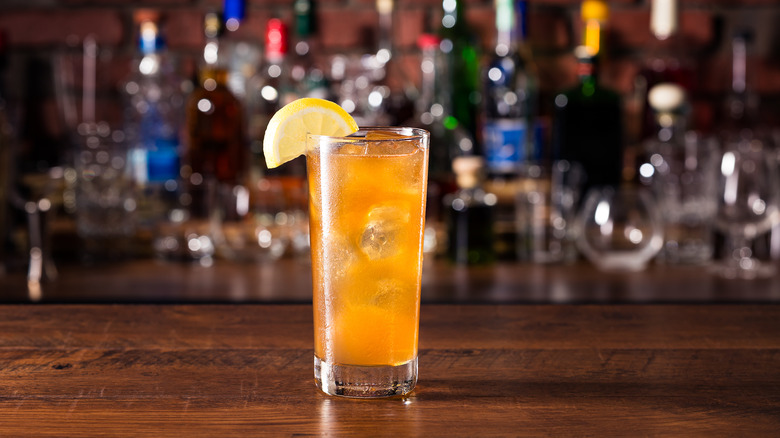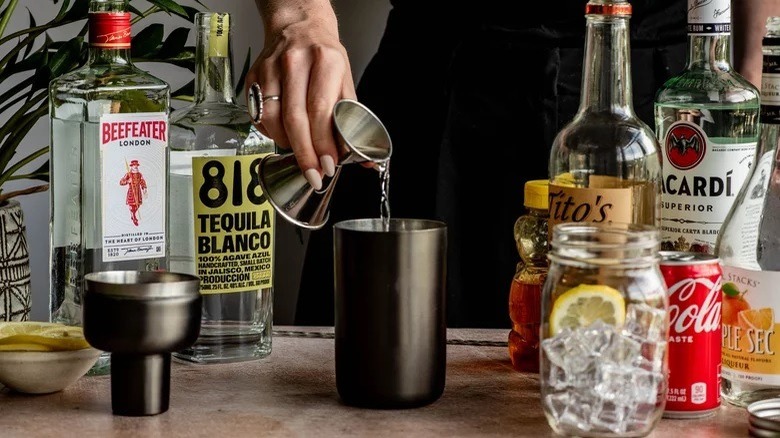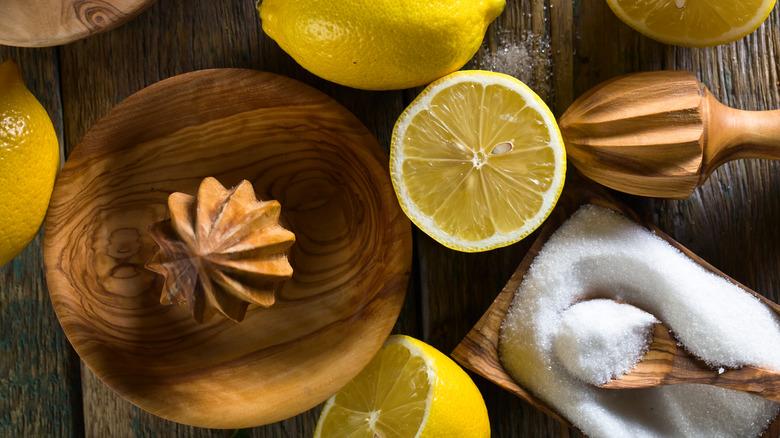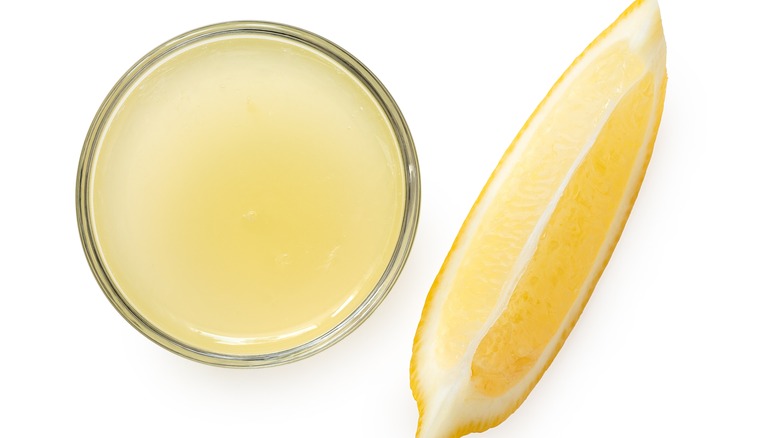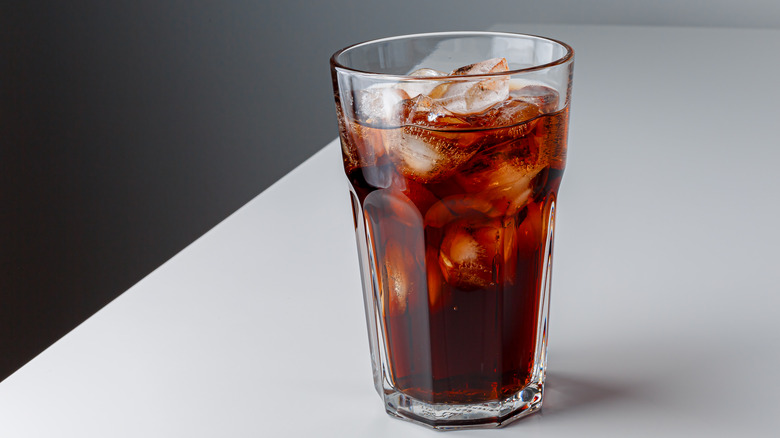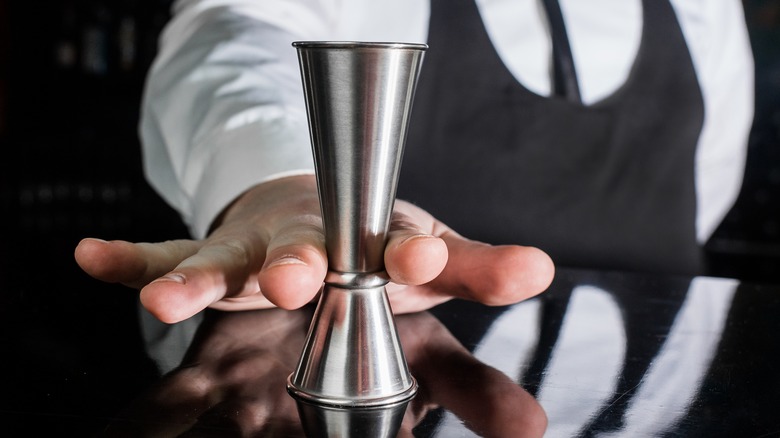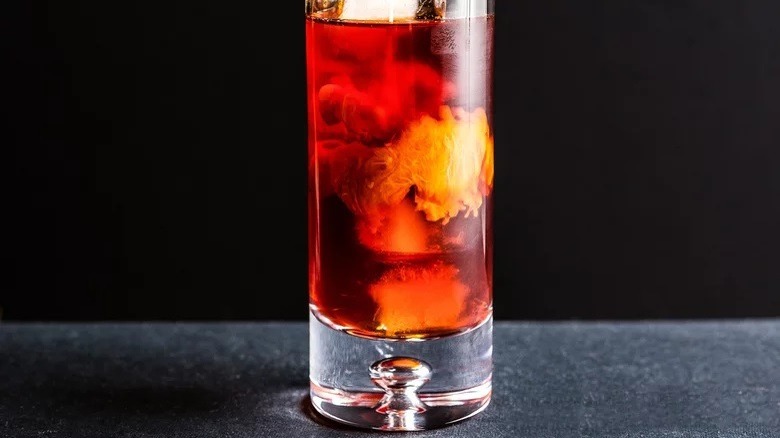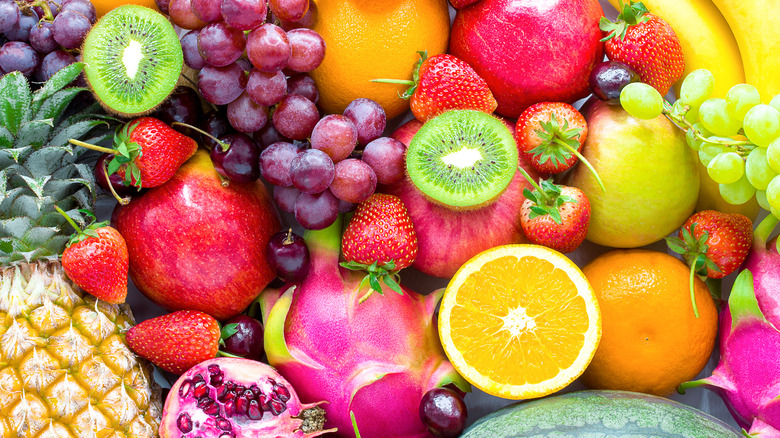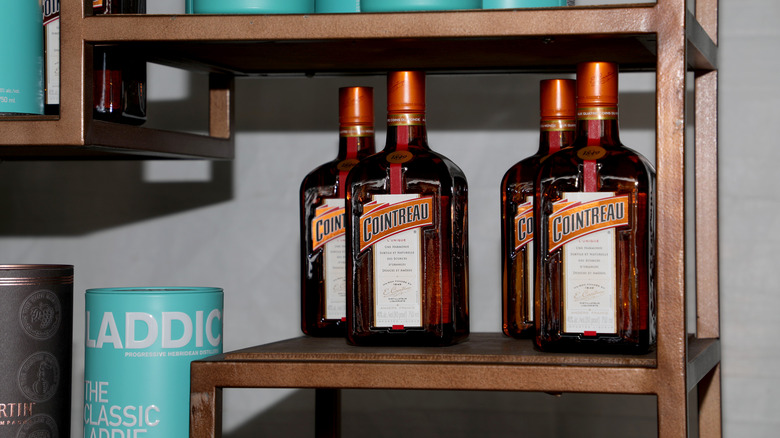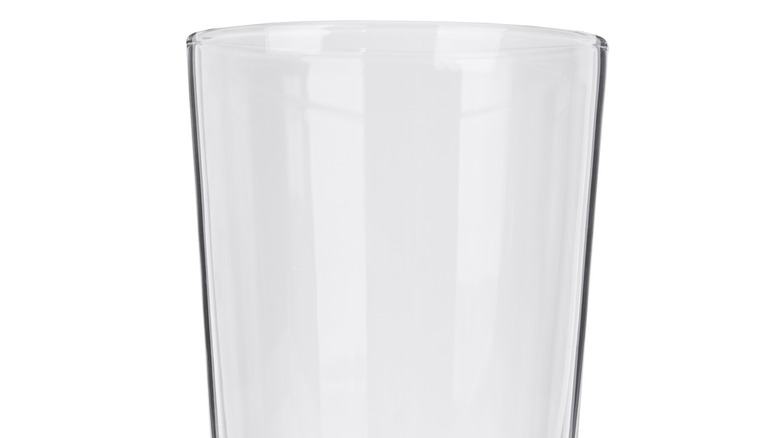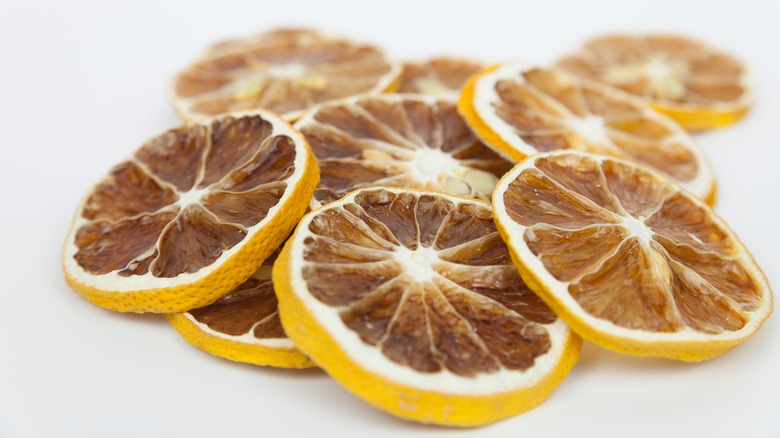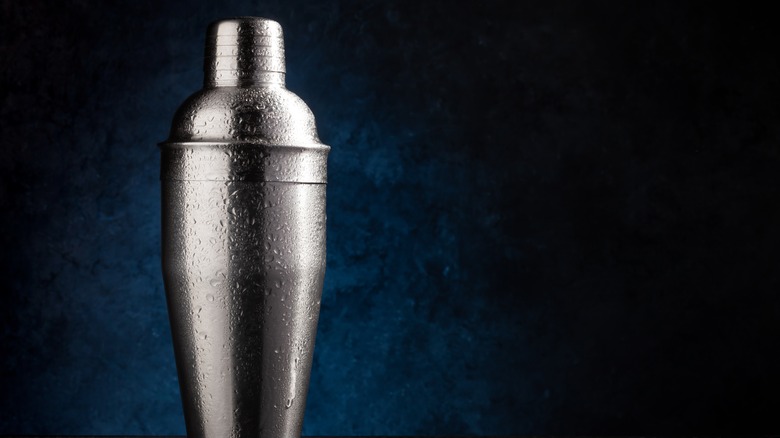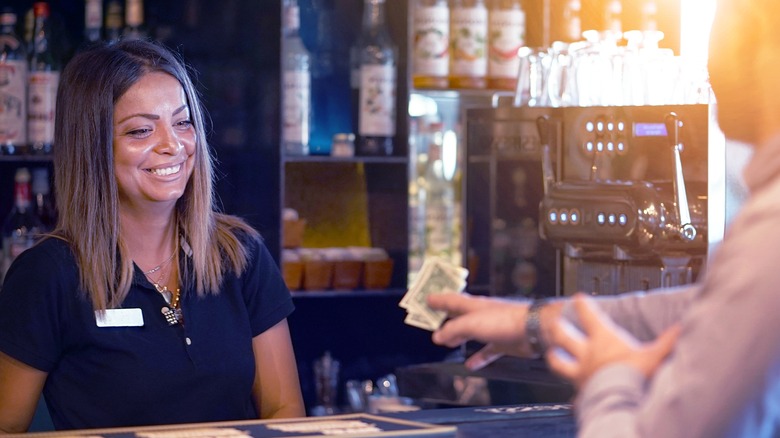15 Ways To Upgrade Your Long Island Iced Tea
Ahh, the Long Island Iced Tea. When it comes to cocktails with a reputation, this one takes the cake. Known for its boozy mix of more liquors than seems sensible, deceptively easy drinking flavor, and general association with wild nights out on the town, a Long Island Iced Tea is a beverage most people have an opinion about. And despite possibly deserving a medal for number of hangovers caused and bad decisions made, these cocktails have come back into fashion in recent years.
Although a Long Island Iced Tea is never going to be the pinnacle of elegance or sophistication when it comes to drinking, there are ways you can take the elixir from scary-mix-of-booze-in-a-cup to a cocktail that's at least somewhat respectable. From avoiding well liquor, to using craft cola, to finding ways to prevent the dreaded misery that often comes from consuming these concoctions, here are the best ways to upgrade your Long Island Iced Tea.
Use better liquor
There's no way around it — Long Island Iced Teas contain a lot of booze. While conventional drinking wisdom warns against mixing liquors, this cocktail keeps drinkers on their toes with its combination of vodka, gin, tequila, rum, and triple sec. Since all the popular clear spirits are present in this potent concoction, it pays to pay a little extra for the good stuff.
Don't get us wrong, it would be almost criminal to put top-shelf liquor in a Long Island Iced Tea. However, if you're at a bar, asking for one step above rail liquor will make a big difference. If you're at the liquor store shopping for the ingredients for a Long Island Iced Tea (which is basically akin to stocking your entire bar cart), we recommend steering clear of anything in a plastic bottle. A good rule of thumb is that if you wouldn't drink a brand on its own, you probably shouldn't drink it in this cocktail.
Understand the recipe
The first thing you should understand about a Long Island Iced Tea is that the whole thing is designed to make a hodgepodge of alcoholic ingredients — which in most cases, would clash terribly with each other — taste good. Finding a way to make ingredients like gin, tequila, and cola go together isn't easy, so we'll give credit where credit is due as far as the ingenuity of this recipe goes.
That said, it's also important to understand that preparing the libation is as much about balance as any other cocktail. A simple and strong Long Island Iced Tea recipe is easy to remember since it calls for equal parts of everything (except the cola, but that gets added last, anyways). Although you can change things up and experiment with different variations, generally speaking, you should stick to the template if you want to preserve the integrity of the delicate balance that exists within a Long Island Iced Tea.
Skip the sour mix
Pre-packaged sour mix, which is essentially a combo of pasteurized citrus juice, sugar, and preservatives, is a mainstay in college bars, dive bars, and any establishment that doesn't have the time or resources to make its own fresh ingredients. Many Long Island Iced Tea recipes call for sour mix, and it's extremely common for bartenders to use it in their renditions, as well.
Although sour mix will certainly get the job done, if you want to upgrade your Long Island Iced Tea, simply opt for homemade simple syrup and fresh lemon juice, instead. The reason you should skip pre-made sour mix for cocktails is that whether you're making something as fun and lighthearted as a Long Island or as refined and sophisticated as a classic gimlet, using fresh ingredients truly makes all the difference.
The only caveat with this one is that oftentimes people find themselves ordering Long Island Iced Teas in bars that fall into one of the categories mentioned above. In this case, we don't recommend getting on the bartender's bad side by requesting they juice some fresh lemon specifically for your Long Island Iced Tea. Trust us.
Stick with fresh lemon juice
Hopefully we've convinced you that using lemon juice and simple syrup instead of sour mix is important, but the other crucial thing to keep in mind here is that your lemon juice needs to be freshly squeezed. Store-bought lemon juice does not deserve a place in your elevated Long Island Iced Tea (or any of your cocktails, for that matter)!
If you think that all juice is created equal, think again. In fact, if we had to pick one tip for how to make cocktails taste better across the board, it would be to always use fresh juice. Plus, Long Island Iced Teas usually only use about a half ounce of the stuff, so you won't have to invest too much time to reap the benefits of this easy upgrade.
Whether you use a handheld juicer or an electric model, just be sure to strain your juice before using it. The last thing you want is a pulpy Long Island Iced Tea.
Opt for craft cola
As you probably know, Long Island Iced Teas are topped with a splash of cola, and Coke or Pepsi tends to be the brand of choice. The soda adds sweetness, effervescence, and some much-needed booze-masking flavor. It's an extremely important ingredient in this context, so swapping it out for something a little more artisan can add dimension and depth to your cocktail by providing more pronounced notes of spice.
Using a craft cola instead of a standard, big-brand soda is an easy way to take this drink from a college bar staple to something that you could find in a reputable cocktail bar (well, maybe). Craft colas tend to rely on cane sugar rather than high fructose corn syrup for their sweetness, and they also usually feature heavier notes of cinnamon, warming spices, and even botanical elements.
Grab a bottle or two the next time you're at the grocery store and experiment with using them to top off your Long Islands. It can be a fun challenge for your palate to see if you can identify the subtle difference using a nice cola can make.
Don't eyeball it
Many people tend to (wrongly) assume that since Long Island Iced Teas are, in a way, just a means to get a lot of liquor into a single glass, measurements don't matter. However, the next time you're in the mood for this boozy refresher, we implore you to break out your jigger (or a liquid measuring cup, if you don't have one).
For one, measuring your ingredients will make your drink taste better. Since this is a drink that is all about balance, even skilled bartenders often struggle to eyeball so many equal proportions. Equally important, measuring means you'll be able to keep the amount of liquor in your drink in check. Since Long Islands contain so much liquor to begin with, accidentally over-pouring a few of your ingredients can take the cocktail from a fun libation to something you're going to regret dearly in the morning. If you stick to the script and only use half an ounce of each type of booze, your drink will actually contain a relatively standard amount of alcohol for a mixed drink, but using more is how people get into trouble. So, do your future self a favor and measure your ingredients!
Try a variation
A classic Long Island Iced Tea is just that — a classic. Like most cocktails that have garnered global recognition, there are several variations that have been created based on the original's basic template. These recipes stick to the basic concept of a Long Island but swap out a few key ingredients.
A delicious variation that's worth adding to your cocktail repertoire is called the Tokyo Tea. This riff swaps out the cola for either lemon-lime soda or seltzer and adds measure of Japan's Midori Melon Liqueur. The result is a bright green beverage that somehow manages to be boozier than the original and yet is still completely quaffable. Sticking with an Asia twist, consider adding actual tea and sweetened condensed milk (along with a few liquor swaps) and try a Long Thailand Iced Tea recipe.
Another example is a cocktail called the Grateful Dead, which also swaps out the cola for lemon-lime soda, but includes raspberry liqueur (we prefer Chambord) for a fruity riff on the original. Some bartenders will also swap out the triple sec for blue curacao in this variation to add some playful color.
Add a fruity flavor
If you like fruity cocktails, there are plenty of ways to add a fresh boost of flavor to a Long Island Iced Tea. For a hint of cherry, simply swap out standard cola for a cherry-flavored variety. You can also make it more pronounced by using cherry-flavored vodka. The same idea can be applied to almost any fruit flavor you can think of. There are scores of flavored spirits on the market, and you can use them interchangeably with their unflavored counterparts when making a Long Island Iced Tea. You can also consider using a fruit-flavored syrup in place of plain syrup or swapping out the triple sec for something like peach schnapps.
The world is your oyster when it comes to adding flavors your cocktail, just remember to keep the cocktail's overall balance in mind. If you add sweetness via a fruity addition, you'll need to take it out somewhere else. We also recommend sticking to just one fruit flavor for this one, since using too many will result in a drink that tastes like fruit punch gone wrong.
Switch up your spirits
Since the booze is undeniably the backbone of this drink, a great way to shake things up is to alter your spirits selection. This tip is admittedly for the more advanced drinker, since you need to have a pretty good grasp on the flavors in different varieties of booze to ensure sure you don't end up with a beverage that tastes off-kilter.
That said, if you feel comfortable in your ability to differentiate the flavors in a citrus-heavy gin and one that screams juniper, then by all means feel free to experiment with more unique varieties of booze in your Long Island. Opt for a funky rum, an extra grassy tequila, or a gin that features out-of-the-box botanicals to really give your cocktail that extra edge.
Just remember, even in a drink like a Long Island Iced Tea, less is often more. If you select one spirit that's highly distinctive, try to keep the remaining ingredients fairly neutral.
Give the orange element a boost
Although most recipes call for triple sec as one of the sweet and citrusy elements in a Long Island Iced Tea, there are much nicer options out there when it comes to orange liqueur. Opting for a brand like Gran Marnier or Cointreau is a great, tasty way to upgrade your beverage. Yes, these bottles cost more, but we think it's an upgrade that's well worth it. Plus, most Long Island recipes only call for half an ounce, so you won't be depleting your stores too badly when you break out the good stuff for this beverage.
Orange liqueur is a key ingredient in everything from a margarita to a lemon drop martini, so having a nice bottle like Cointreau on your bar cart means you'll be able to easily whip up quality renditions of classic cocktails with ease. We promise that you get what you pay for, even in the context of a Long Island Iced Tea.
Use a large enough glass
The lengthy ingredient list in a Long Island Iced Tea means this cocktail isn't lacking in volume — so you need to use the appropriate glassware. We love the aesthetics of a sleek, dainty cocktail glass as much as anyone, but using too small of a drinking vesicle will prevent you from topping your concoction with as much cola as needed to balance out all that booze.
A pint glass is a solid, accessible option that can accommodate a cocktail with as much volume as a Long Island, while still allowing you to add enough ice to keep things frosty. Mason jars are another good choice if you want something that will speak to your inner hipster. You can even get creative and purchase fun, over-sized glassware to help cultivate the carefree vibes that usually accompany situations in which Long Island Iced Teas are consumed. Whatever you choose, just be sure you have enough room for the soda.
Adorn with a fancy garnish
Whether it's a low-ABV sipper or a high-octane powerhouse like a Long Island Iced Tea, no cocktail is complete without a garnish. The traditional accompaniment for a Long Island is a simple lemon wedge, but you can upgrade your beverage by stepping up your garnish game.
If you want to stick to something citrusy, we recommend swapping out the wedge for a dehydrated lemon wheel. Not only do we think it looks a lot nicer, but it also prevents the drinker from adding any additional citrus to the drink. If your Long Island was made correctly, then adding extra juice will throw off the cocktail's carefully crafted balance.
Another good option is a Luxardo cherry. These tasty treats shouldn't even be in the same category as their bright red, dye-saturated maraschino counterparts, and they add a touch of sophistication and luxury to any Long Island. We also think these cocktails are the ideal beverage to which to add a fun, non-edible garnish like a cocktail umbrella.
Shake it up — literally
Professional and at-home bartenders alike often tend to make the mistake of building a Long Island Iced Tea directly in the glass. While giving the drink a good stir will do in a pinch, as a general rule of thumb, any cocktail that contains citrus juice should be shaken. Shaking your Long Island instead of building it will ensure everything gets nice and incorporated and doing so will also add texture by adding tiny air bubbles to the drink.
Just remember that when you're adding ingredients to your shaker, you should never add anything that's carbonated (in this case, the cola). Trying to shake anything with bubbles will result in a cocktail explosion, so just add the soda at the end. Shaking your Long Island is a quick and easy way to upgrade your beverage. It's also a fun way to feel like a real pro the next time you're charged with playing the role of at-home bartender.
Instill confidence in the bartender
Ordering a Long Island Iced Tea is a red flag for bartenders — so you need to do everything you can to order in a manner that makes them feel confident that you aren't going to give them any issues. Bartenders know that oftentimes people who order these drinks just want to get wasted, and although a bartender's job is in fact to help people catch a buzz, no bartender enjoys dealing with people who take it too far. Drunk people usually behave badly and tip poorly, so it's understandable why bartenders often cringe when someone orders a drink that's known for its ABV.
This is not to say you shouldn't order a Long Island Iced Tea if that's the beverage your heart truly desires, but there are some ways you can easily mitigate your bartender's concern and avoid the dreaded side-eye. First and foremost, you need to be sober when you order (a responsible bartender won't serve you if you're drunk, anyways). You also need to be courteous, polite, and follow the basic dos and don'ts of ordering drinks at a bar. Finally, don't forget to leave a nice tip. You'll enjoy your drink a lot more if you don't feel like you ruined someone's night by ordering it, and the only way to change the stigma that surrounds this iconic beverage is to act accordingly.
Consume with caution
If the words "Long Island Iced Tea" conjure up bad memories of a crazy night that led to a vicious hangover, you're not alone (hey, we've been there, too). If you're ready to wipe the slate clean and cultivate a better relationship with this boozy beverage, we have an important piece of wisdom for you: limit yourself to one or two of these babies.
It's hard to think highly of a beverage if you feel like you need medical intervention the day after drinking it, so moderation really is the key to upgrading your general views on a Long Island. The same advice goes for alcoholic beverages of any kind, but Long Island Iced Teas are deceptive in that they don't taste as boozy as they really are, so it's important to set (and stick to) your limits if this is your drink of the night. Long Islands can be such a recipe for disaster that some bars even have limits on how many they'll serve patrons.
